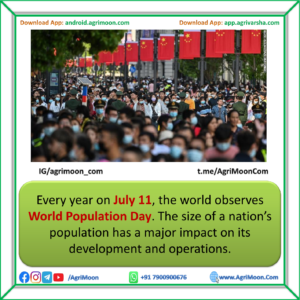Why World Population Day celebrated ?
Every year on July 11, the world observes World Population Day. The size of a nation’s population has a major impact on its development and operations. The bigger a country’s population, the more difficult it is to develop at a quicker rate. As a result, reducing overpopulation is essential, whether on a national or global scale, to ensure the long-term growth of our existing resources.
It took hundreds of thousands of years for the world population to reach one billion, and then it increased sevenfold in just another 200 years or so. The world population passed the 7 billion barrier in 2011, and it now stands at approximately 7.7 billion, with an anticipated increase to around 8.5 billion in 2030, 9.7 billion in 2050, and 10.9 billion in 2100.

This substantial increase has been driven mostly by an increase in the number of individuals reaching reproductive age and has been followed by significant changes in fertility rates, increased urbanization, and accelerated migration. These tendencies will have far-reaching consequences for future generations.
Theme of World Population Day:
The theme for World Population Day 2021 is “Rights and Choices are the Answer: Whether baby boom or bust, the solution to shifting fertility rates lies in prioritizing all people’s reproductive health and rights.”
Also Read: International and National Agriculture Days
History of World Population Day:
Sure, you might know that there are more than seven billion people on earth right now, but how often do you stop to think about what that really means? Five Billion Day, in 1987, was meant to acknowledge the date on which the world’s population reached an estimated five billion people, which supposedly happened on July 11 of that year (hence the annual date for World Population Day). And look how much the population has increased since then! Population issues cover a lot of territories, from family planning, gender equality, and environmental impacts to human rights concerns.
World Population Day was established in 1989 by the Governing Council of the United Nations Development Programme — UNDP. The inspiration for this holiday was the peaking public interest in the celebration of ‘Five Billion Day’ on July 11, 1987. This original date was decided to be set as ‘World Population Day’ by the United Nations General Assembly, and resolution 45/216 made this official in December 1990.
World Population Day serves to highlight the growing problems that come with a growing global population. Overpopulation is a crucial issue, especially considering that world resources are depleting at an unsustainable rate. Awareness about the effects of overpopulation on development and nature is emphasized. The increasing population also sheds light on health problems faced by women during pregnancy and childbirth, making the need for family planning, gender equality, and maternal health more important than ever.
The issue of population is also causing strain on society: heinous crimes are happening more than ever in the areas of gender inequality and human rights, especially in developing countries. Leadership is already doing a subpar job at taking care of its citizens, and as more people come into the world, violations such as human trafficking and child labor are increasingly becoming normal.
Also Read: NABARD Foundation Day (12 July)
Traditions of World Population Day
This event is celebrated in various countries around the world by hosting seminars and public discussions, whether virtual or at conferences. Educational sessions and workshops are also held by institutions. Slogans and banners are distributed and people post about it on social media.
By the Numbers of World Population Day
7.8 billion – the current population of the world.
1,442,857,138 – the highest population rate of a country in the world — China.
1,388,712,570 – the second-highest population rate of a country in the world — India.
5 million – the estimated population of the world at the dawn of agriculture in 8000 B.C.
1800 – the year when the world population hit one billion.
200 – the projected number of years it will take for the population to double again.
2057 – the year The United Nations projects the world population to reach 10 billion.
31% – the percentage of the world population who are Christians.
23% – the percentage of the world population who are Muslims.
90 billion tons – the number of resources extracted from Earth every year.
WORLD POPULATION DAY FAQS
What was the theme of World Population Day 2020?
The theme for World Population Day 2020 was ‘How to safeguard the health and rights of women and girls now.’ This theme was chosen to raise awareness about the reproductive vulnerabilities and health needs of women and young girls, especially during the COVID-19 pandemic.
How many people are in the world in 2021?
There are 7.9 billion people in the world in 2021.
How do we celebrate Population Day?
World Population Day is all about raising awareness of controlling the population, and the risks and consequences of a disproportionate population-to-resources ratio. The issue is discussed on social media the most, so if you have a blog or other social platform for raising awareness, raise your voice on how to take precautions and combat population issues.
When Is World Population Day 2021?
World Population Day is observed annually on July 11.
For Daily Update follow us at:
Facebook Telegram Whatsapp Instagram YouTube
If you are facing any Problem than fill form Contact Us or send Mail at info@agrimoon.com


[…] World Population day […]